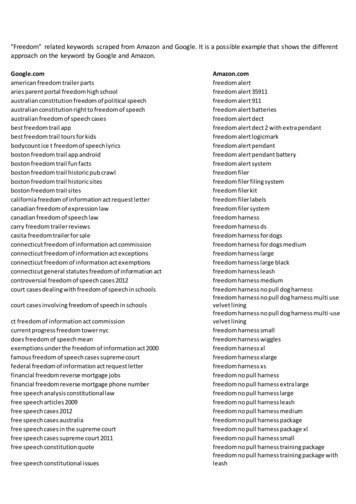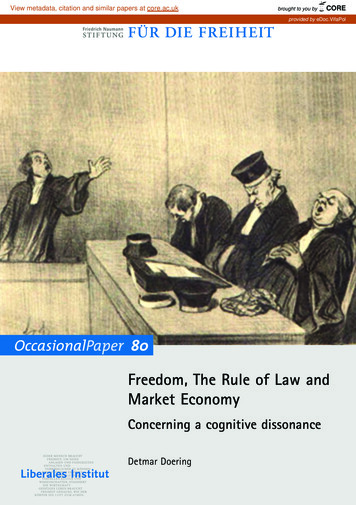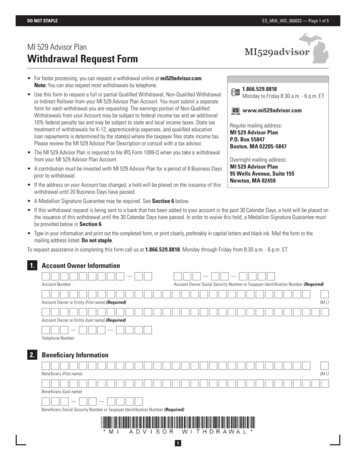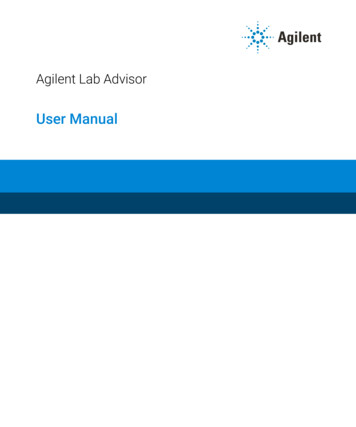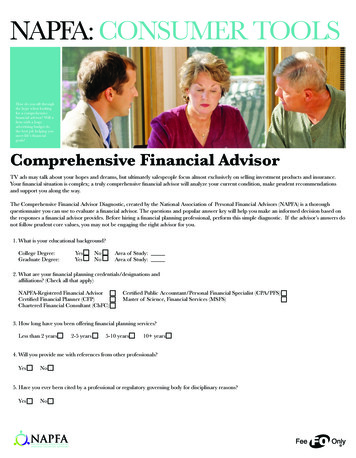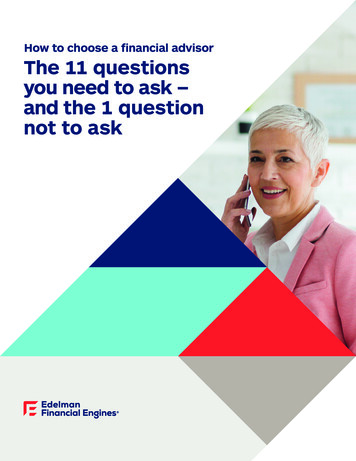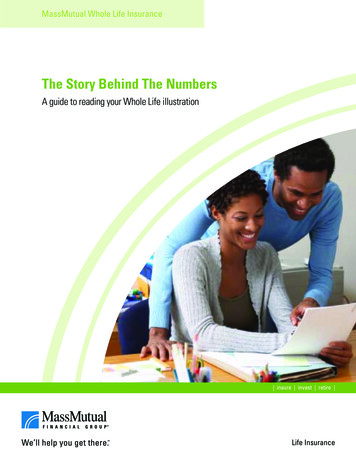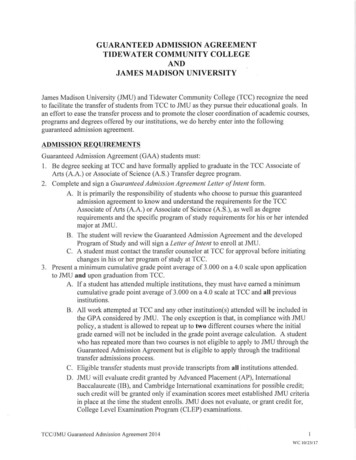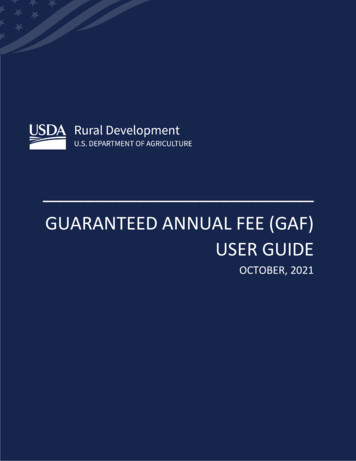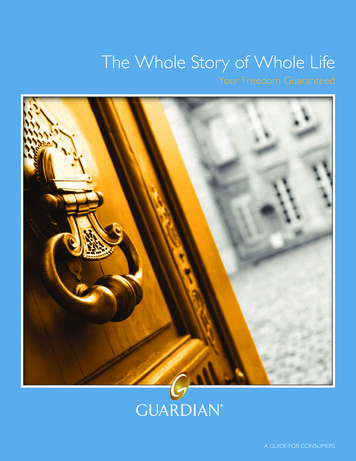
Transcription
The Whole Story of Whole LifeYour Freedom GuaranteedA GUIDE FOR CONSUMERS
Introduction“Whole life is a versatile financial instrumentdevised for the protection of families, businesses,and the creation and enhancement of wealth.To appreciate the great value of this type of lifeinsurance protection, one needs to explore howit works, its uses, its benefits, and the optionsyou have in structuring a contract to meet yourspecific needs, and why Guardian is the companyof choice.”
Chapter 1:How Does Whole Life Work?Whole life is an insurance policy that provides lifetime insurance protection withsignificant guarantees and tax benefits for the policyowner. These guaranteescan be viewed as either rates or values. When actuaries design a whole life policy,they begin by determining which rates are going to be guaranteed. Once theguaranteed rates have been set, they are used to determine policy premiums andvalues. Guaranteed rates and values are based upon conservative assumptions.A mutual life insurance company, such as Guardian, will then adjust these ratesand values to current conditions through the mechanism of a non-guaranteeddividend, which is considered to be a refund of premium. Because lifeinsurance is seen as financially beneficial to society, significant tax benefits havebeen given to it – benefits that are not found with other financial instruments.WHAT ARE THE GUARANTEED RATES?1A whole life policy is built upon a foundation of three guaranteed rates: The guaranteed mortality rate – This guarantee comes from the 2001 CSOtable, a table of guaranteed mortality rates that was adopted by the NationalAssociation of Insurance Commissioners in 2002. The guaranteed interest rate – This rate for Guardian policies is 4.0% or5.0% (depending on the policy) for the entire life of the policy. The guaranteed expense factor – An allocation for expenses that is coveredin guaranteed values.WHAT ARE THE GUARANTEED VALUES?1The three guaranteed rates are combined in an actuarial formula that resultsin three guaranteed values. It is this trio of guaranteed features that sets wholelife policies apart from all other types of financial instruments. Whole lifeinsurance has: A Guaranteed Level Premium – The annual premium is contractuallyguaranteed to never change. Guaranteed Death Benefit – The level death benefit is contractuallyguaranteed never to go down. A Guaranteed Cash Value – The contractually guaranteed cash value growseach year until it is equal to the face amount of the policy at a specified age,typically age 100 or 121. (Prior to the 2001 CSO table, it was age 100.)All whole life insurance policy guarantees are subject to the timely payment of all required premiums and theclaims-paying ability of the issuing insurance company. Policy loans and withdrawals affect the guarantees byreducing the policy’s death benefit and cash values.1 1
The graph below illustrates the guaranteed values of a whole life insurance policywithout any dividend values. The Guaranteed Death Benefit of 500,000 is acombination of Guaranteed Cash Value and Guaranteed Net Amount at Risk.2Year by year, the Guaranteed Cash Value increases until it is equal to the faceamount of the policy at age 121. 500,000 Whole Life Insurance Guaranteed Values — BasePolicy Guaranteed Cash Value and Guaranteed Net Amountat Risk — Age 35 - 6,525 Annual Premium 707580859095100 105 110 115120AGE— Guaranteed Net Amount At Risk— Base Policy Guaranteed Cash Value“Whole life provides lifetime insuranceprotection with significant guaranteesand tax benefits.”The examples shown here and on page 4 are based on a hypothetical policy not available for sale, usingGuardian’s Whole Life Paid-Up at Age 95 policy, preferred risk class, and averaging male and female values forissue age 35. A full illustration, showing both guaranteed and non-guaranteed values, must be provided by aGuardian representative to individuals applying for any Guardian whole life insurance policy.22Net Amount at Risk is the difference between the policy death benefit and the cash value.
DIVIDENDSWhole life offers the ability to provide value in excess of its guarantees throughdividends. Dividends are paid to the policyholders if declared by the Board ofDirectors. When dividends are declared, they have three components: The insurance company’s current investment rate in excess of theguaranteed rate promised in the policy;DID YOU KNOW.Walt Disney, unable to secure asubstantial bank loan, used the cashvalue from his whole life policy to builda sprawling theme park that is nowknown to the world as “the happiestplace on earth.” Mortality experience, which is better than that which is guaranteed in thepolicy; and Expenses of policy administration, which are less than the cost guaranteedin the policy.The graphs on the next page illustrate how a whole life policy can grow in valuewhen paid-up additional insurance is purchased with dividends.WHAT ARE MY DIVIDEND OPTIONS?Diverse policyowners have different needs. Whole life offers a variety of dividendoptions to choose from, which allows you to customize your coverage so that it’sright for you. The dividend option may be changed year by year to address yourneeds as they change over your lifetime. By far the most widely selected dividend option is to apply dividends topurchase Paid-Up Additions (PUA). A Paid-Up Addition is guaranteedpermanent, paid-up participating life insurance. This option providesyou with a growing cash value and death benefit that is guaranteed oncepurchased. Under this option, each year as dividends are declared, moreand more PUAs are purchased, which in turn earn their own dividends.Over time, the accumulation of PUAs will offset the effects of inflation byproviding a greater level of death benefit protection and accumulated cashvalues. Following are Guardian’s other current dividend options: Dividends may be paid to you in cash. Dividends may be used to reduce your premium. Additional term insurance may be purchased with your dividends. Dividends may be allowed to accumulate with interest. Dividends may be used to pay back an existing loan on a policy.The graph on the top of page 4 illustrates how the death benefit of a wholelife policy can grow in value with Paid-Up Additional Insurance purchasedby dividends.3
Base Policy Death Benefit With Dividends PurchasingPaid-Up Additions* — 500,000 Base Policy Age 35,Best Class - 6,525 Annual Premium ,000035404550556065707580859095100105 110 115120AGE— PUA Death Benefit— Base Policy Guaranteed Death BenefitThe graph below illustrates the four elements of a whole life policy: The base policy guaranteed cash value; The base policy net amount at risk; The paid-up addition cash value; and The paid-up addition net amount at risk.These four elements constitute the total death benefit of a whole life policy.Policy Elements – Whole Life With Dividends PurchasingPaid-Up Additions — 500,000 Base Policy Age 35,Best Class - 6,525 Annual Premium* ,000035404550556065707580859095100 105 110 115120AGE— PUA Net Amount At Risk— Base Policy Net Amount At Risk— PUA Cash Value— Base Guaranteed Cash Value*Based on Guardian’s 2014 dividend scale. Dividends are not guaranteed. They may be declared annually byGuardian’s Board of Directors. Guardian has paid a policyholder dividend every year since 1868.4
TAXATION PROTECTION3Because of the contribution that life insurance makes to the welfare of societyby providing protection for surviving family members, it is vested with thefollowing significant tax benefits: Income tax-free death benefits4 . Tax-deferred buildup of cash values inside of the life policy. Access to policy values on a tax-favored basis. The cash values of life insurance policies may generally be accessed on a taxfavored basis by withdrawals or through policy loans.5 Withdrawal from a life insurance policy is permitted on a First-In First-OutBasis (FIFO)6. This means that withdrawals to the extent of cost basis areconsidered a tax-free return of cost basis.7 You can withdraw cash value from a policy without triggering income tax onany gain that has been borrowed from the policy.3Guardian, its subsidiaries, agents and employees do not give tax or legal advice. You should consult your taxor legal advisor regarding your individual situation.4Employer-owned life insurance must comply with the rules set forth in IRC Section 101(j) in order to ensuretax-free death benefits.5Policy benefits are reduced by any outstanding loan or loan interest and/or withdrawals. Dividends, if any, are affectedby policy loans and loan interest. Withdrawals above the cost basis may result in taxable ordinary income. If the policylapses, or is surrendered, any loans considered gain in the policy may be subject to ordinary income taxes. If the policyis a Modified Endowment Contract (MEC), loans are treated like withdrawals, but as gain first, subject to ordinaryincome taxes. If the policy owner is under age 59½, any taxable withdrawal is also subject to a 10% tax penalty.6FIFO tax rules apply as long as the policy has not been classified as a Modified Endowment Contract (MEC).7 Cost basis is the contribution that is made to a life insurance policy.5
Chapter 2:What are the Different Usesfor Whole Life?Whole life insurance provides a means by which a family or business may enjoythe benefit of the family member’s or employee’s human life value when thefamily or business is threatened by the loss of that individual.HUMAN LIFE VALUE PROTECTIONProperty values, whether they exist in the context of a family or a business, arein fact the result of human effort. Human life value is clearly seen in a familywhenever income is earned to provide for that family’s economic needs. Humanlife value is clearly seen in a business where a key person is often identified as asignificant contributor to revenue and earnings.Whole life insurance provides a means by which an individual may insure theirhuman life value.Solomon Huebner defines human life value as the capitalized monetary worthof the earning capacity resulting from the economic forces that are incorporatedwithin our being: namely, our character and health, our education, training, andexperience, our personality and industry, our creative power, and our driving forceto realize the economic images of the mind.8Most people see the importance of insuring the value of property, such as theirhome or car, for its replacement value and are able to do so through the purchaseof casualty insurance. The human life value of an individual, which is by far themost valuable asset of a family or business, is also insurable for its replacementvalue on a permanent basis with whole life insurance. Whole life insuranceprovides an affordable, effective way of permanently indemnifying a family orbusiness against the loss of its most valuable asset.There are many benefits that a family may enjoy from the protection of income,such as the purchase of a home, the rearing and education of children, and theenjoyment of life. The indemnification of the breadwinners in a family will helpto ensure that these benefits will continue to the survivors in the event of theinsured’s death.“Human life value is the most valuable86asset.S.S. Huebner, The Economics of Life Insurance, page 5, (Executive Asset Mgmt. 3rd ed. 1996) (1927)
FAMILY PROTECTIONThe death benefits of life insurance can help to assure the economic continuityof a family at a time when it is faced with the greatest of all possible traumas: thedeath of a beloved father, mother, husband or wife. Whole life insurance can alsohelp to ensure financial stability through the funding of: Mortgage protection; Education funding; andDID YOU KNOW.In 1913, the United States Congressgave special tax treatment to whole lifeinsurance as an incentive for individualsand business owners who wereexpected to take more responsibilityfor their financial future. Those sameunique tax benefits remain in place forpolicyholders today. Income needs.BUSINESS PROTECTIONBusinesses face special insurance funding needs in order to provide a businesscontinuity plan that will protect the owners in the event of death. Whole lifeinsurance is ideally suited to provide the capital needed to adequately buy theinterests of a deceased owner and indemnify the business against the loss of theservices, expertise, and skill of a key person. Life insurance is ideally suited toaddress four major areas of business planning: The funding of buy-sell agreements and stock redemption plans; The funding of supplemental retirement programs; Key person indemnification; and The payment of loans and mortgages. ESTATE PLANNINGPlanning for the orderly transfer of property at death can help to minimize taxesand provide for heirs in a way that will reflect an individual’s desires. Whole lifeinsurance plays a key role in providing for loved ones by offering: Adequate liquidity to pay estate and inheritance taxes; Assets to generate income for a surviving spouse and children; Estate equalization among heirs; and Funding for special needs children.ASSET MAXIMIZATIONOne of the unique benefits of whole life insurance is the way that it enhancesthe value of other assets in your estate. The presence of guaranteed whole lifeinsurance gives the owner the ability to use estate assets in ways that would not7
be possible if the insurance did not exist. Whole life is the “permission slip” thatmay enable you to maximize retirement income and your personal net worth.For example: Th e Power to Consume – The presence of whole life insurance in your estatewill allow other assets to produce greater income by providing access to theprincipal as well as interest as a source of income. Life insurance gives theowner the power to consume assets that would otherwise have to be managedin an ultra-conservative fashion in order to preserve the principal and theincome stream it produces. Charitable Remainder Trust – The cost of successfully building a businessor managing a personal investment portfolio is often measured by theenormous capital gains tax that must be paid when a business owner sells abusiness interest or portfolio holdings in order to fund retirement income.Often financial success brings with it a desire to express benevolence towardsthose charitable causes that are of particular interest. With a CharitableRemainder Trust, these two seemingly diverse issues can come together in aplan that provides:—— A lifetime income for a benevolent donor;—— A substantial bequest to a charity of the donor’s choice;—— Avoidance of the capital gains tax; and—— Significant income tax deductions.The existence of permanent whole life insurance in the estate of a donor makesit possible to achieve the desired charitable intent with all the collateral benefits,while maintaining a comparable legacy for the donor’s heirs.of a8family or business.”
Chapter 3:What are the Benefits of WholeLife Insurance?THE PROTECTION OF AN INSTANTPERMANENT ESTATEInstantly, with the payment of the first premium, Guardian sets aside the entiredeath benefit for your family. Whole life insurance provides a guaranteed deathbenefit for the entire life of the insured.DISABILITY PROTECTIONLife insurance is uniquely different from all forms of savings and investmentvehicles, such as bank accounts, IRAs, 401(k) accounts, mutual funds, andbrokerage accounts, because it can continue to be funded even if you aredisabled. Disability usually brings with it the strain of reduced income, increasedexpenses, and dissolution of existing savings and investments. The Waiver ofPremium Rider guarantees that if disabled, you (as a policyowner) will not losethe umbrella of financial protection provided by your whole life insurance policy.The policy will continue to provide death benefit protection, the cash values willcontinue to grow, and dividends will continue to be paid just as they would if youhad not been disabled.LIABILITY PROTECTIONIn many states, the benefits of life insurance are protected from the claims ofcreditors. If your state provides this legal protection, the cash values and deathbenefit of a whole life policy will be protected from lawsuits that can claim otherassets, such as bank accounts, mutual funds, and brokerage accounts.DISTRIBUTION LIKE A WILLLife insurance is distributed like a will: You specify who and how much of thebenefit will be distributed to each beneficiary. Unlike a will, however, life insurancehas the added benefit of privacy. Wills, once probated, become public documents.The distribution of a life insurance policy’s death benefit is a private, contractualdriven transaction between the policyowner and insurance company – thedistribution passes outside of a will and thus provides privacy for the beneficiary.“Instantly with the payment of the firstpremium, Guardian sets aside.9
DID YOU KNOW.Estate taxes can wipe out the accruedvalue of retirement accounts, realestate, and businesses by forcingbeneficiaries to liquidate assets. Wholelife’s income tax-free, guaranteed deathbenefit can cover the bill and protectthe wealth that a policyholder hasworked to accumulate.TAX-FREE DEATH BENEFITThe death benefits of life insurance policies are generally free from all federalincome taxes. The enormous value of this benefit must not be underestimated,especially in light of constantly growing government expenditures and taxes.TAX-DEFERRED GROWTHThe growth of cash value inside of the life insurance policy is deferred fromtaxation while the funds remain in the policy. This is yet another wealthprotecting benefit that whole life insurance provides to families and businesses.TAX-FAVORABLE ACCESS TO POLICY CASH VALUESTHROUGH WITHDRAWALSDuring the insured’s life, cash values can be accessed under favorable FIFO(First-In-First-Out) tax rules. This means withdrawals to the extent of cost basisare considered a tax-free return of cost basis.TAX-FAVORABLE ACCESS TO POLICY CASH VALUESTHROUGH POLICY LOANSDuring the insured’s life, loans taken against a life insurance policy will nottrigger a taxable event, even though the policy may have a large gain in excess ofpremiums paid.SELF-FUNDINGYou have the option of having the policy pay for itself over time by applyingdividends to pay premiums. This feature may be invoked or changed at any timeto meet the changing circumstances of your life.the10entire death benefit for your family.”
ABILITY TO PAY ITSELF BACK FROMANTICIPATED EARNINGSOnce a policy loan has been taken, the annual dividend can be used to help payback a policy loan.YOU CAN MAKE DIRECT LOANS TOYOURSELF FOR ANY REASONWhole life insurance can free a policyholder from reliance upon commerciallenders. Cash values can be accessed on a demand basis via a policy loan at anytime and for any reason without the application and approval process that isrequired for consumer or business loans.COLLATERAL FOR A LOAN FROM A BANKA whole life insurance policy may be used as collateral to obtain a loan from a bankat favorable interest rates. The ability to either borrow directly from the insurancecompany or from a bank gives the owner of a whole life insurance policy significantflexibility when there is a need to access policy values.FLEXIBLE LOAN REPAYMENT TERMSLife insurance policy loans are flexible to the extent that they do not need tobe paid back unless you decide to pay them back. Once a loan is taken out ona policy, it can be paid back at the discretion of the policyowner. If they are notpaid back during the lifetime of the insured, any remaining loan balance will bededucted from the policy net death benefit. When a policy loan is paid back, therewill be a commensurate increase in the cash value of the policy, which may bereborrowed at a future date or paid out to the beneficiary.DEATH BENEFIT INCREASEWhen dividends are used to purchase Paid-Up Additions, death benefits willgrow, helping to offset the eroding effects of inflation. Once a dividend haspurchased Paid-Up Additions, the additional death benefit and cash value ofthe paid-up additional insurance is guaranteed.11
Chapter 4:What Types of Whole LifeInsurance are Available?DID YOU KNOW.The cash value accumulating insidea whole life contract can act as a“second emergency fund” to helpcover retirement, medical expenses,long-term care, a down payment on ahouse, or other needs.9There are several types of whole life insurance that are designed to provideflexibility and options in the structuring of an insurance program:LEVEL PREMIUM WHOLE LIFEThis is the most popular type of whole life insurance, and it is offered witha guaranteed level premium to either age 95, 99, or 120. The level premiumstructure makes the policy ideally designed to provide affordable lifetimeinsurance coverage. As a policyowner, the guaranteed level premium structuregives you peace of mind, because regardless of what happens in a volatile world,your premium will not change.LIMITED PAYMENT WHOLE LIFEThis type of policy has a fixed level premium like a Level Premium Whole Lifepolicy, but the premium is only payable for a fixed period of time. The advantageof these limited payment policies is that they are guaranteed to be paid up atthe end of the payment period. Thus, they allow valuable insurance coverage tocontinue for the insured’s entire life without any payment required at later ages.“The guaranteed level premium structure helps providepeace of mind.”912From National Underwriter article by Warren S. Hersch. November, 2004.
Chapter 5:What Options Does GuardianWhole Life Insurance Give You?Guardian’s whole life insurance products offer many riders that you may add to apolicy in order to customize the coverage to suit your specific needs. Some of themore popular riders are:WAIVER OF PREMIUMProtects you in the event of disability by paying the premium if you shouldsuffer a qualifying disability. Because the premium will be paid, cash values willcontinue to build, dividends will continue to be paid, and the financial securityof your whole life policy will permanently protect you and your family.ENHANCED ACCELERATED BENEFIT RIDERAllows you to accelerate the benefits of a whole life policy for chronic andterminal illnesses. A portion of your policy’s death benefit may be acceleratedduring your lifetime if you become permanently unable to perform two out ofsix Activities of Daily Living (ADLs) or if you become permanently cognitivelyimpaired.GUARANTEED INSURABILITY OPTION (GIO)Gives the owner the right to purchase additional insurance on the insured’slife without evidence of insurability. There are up to eight option dates on theanniversaries nearest the insured’s 25th, 28th, 31st, 34th, 37th, 40th, 43rd,46th, 49th, 52nd, 55th, and 58th birthdays and/or upon marriage, the birth oradoption of a child, the birth or adoption of a grandchild, a home purchase, childenrollment in college, or a 20% income increase for the insured. The GIO optionbecomes all the more valuable in the event of disability.An insured who is disabled and has their premium waived under the originalpolicy rider may exercise the GIO rider on the option dates, and Guardian willpay the premium on the new policy as well as on any existing policy(ies) thathave the Waiver of Premium rider.13
PAID-UP ADDITIONS RIDER10Gives the owner the right to purchase paid-up participating insurance on theinsured’s life. The real benefit of this rider is that it gives premium flexibility sothat you may add varying amounts of premium to a whole life policy. The greaterthe premium paid into a policy, the greater will be the protection afforded by thepolicy; the greater will be the guaranteed cash value; and the greater will be thetax-deferred accumulation of cash values and dividends.RENEWABLE TERM RIDER10Purchases 10-year renewable and convertible level term insurance.ACCIDENTAL DEATH BENEFIT10Can be added to a policy to provide an additional death benefit in the event thatdeath occurs by accidental bodily injury. The benefit will be doubled if the injuryis sustained while a passenger in a public conveyance.customized“Whole life insurance may befor your specific needs.”1014There is an additional premium cost when these riders are selected on a policy.
Chapter 6:Why Guardian?QUALITY COMPANYGuardian is recognized by all the major rating agencies as a company thatprovides superior financial strength. The following table shows Guardian’sratings from each of the five major rating agencies.DID YOU KNOW.Founded over 150 years ago, Guardianhas paid out annual dividends to ourpolicyholders every year since 1868.GUARDIAN RATINGSRating AgencyRatingA.M. BestA (Superior – highest of 15 ratings)Fitch RatingsAA (Very Strong – 2nd highest of 21 ratings)Moody’s Investors ServiceAa2 (Excellent – 3rd highest of 21 ratings)Standard & Poor’sAA (Very Strong – 2nd highest of 20 ratings)COMDEX98 (Extremely Safe)11Ratings are current as of May 2014.MUTUAL COMPANYGuardian is proud to be one of the few remaining major mutual insurancecompanies in the nation. We are owned by our policyholders, who sharedirectly in our annual earnings. We have no stockholders expecting dividends,immediate returns or short-term growth. Guardian has no stock and thus nostock options exercisable by senior management that can sap the financial vitalityof the company. Guardian is committed to its status as a mutual life insurancecompany and is here to provide for policyholder insurance needs, now and farinto the future.SOLID HISTORYFounded in 1860, we have paid out dividends to our individual life policyholdersevery year since 1868. As a mutual company, we have been able to provide one ofthe lowest net costs on ordinary life coverage year after year, while still retaining asolid financial position.11COMDEX is not a rating, but a composite of all ratings that a company has received from the fourmajor rating agencies (A.M. Best, Standard & Poor’s, Moody’s, and Fitch). COMDEX percentile ranksthe companies, on a scale of 1 to 100 (with 100 being the best).15
committed“Guardian isto its status asa mutual life insurance company and is here toprovide. now and far into the future.”16
Concluding Note“The protection and wealth-enhancing benefitsof whole life insurance make it the mostcomprehensive financial tool available today. Itsgreat value is enhanced by its flexibility, whichenables it to be customized for a variety ofconsumer needs. Premium flexibility is providedby existing paid-up additions and dividend options.The loan feature and the ability to withdrawdividends provide readily available liquid assets.Together, the guaranteed cash value, guaranteeddeath benefit, and guaranteed premium providepolicyowners with a solid foundation for financialprotection and the ability to build wealth in aturbulent and uncertain world.”“The Whole Story of Whole Life” revised 2009, Clifford P. Kitchen, CLU , ChFC , CFP, CFA, MSFSCopyright 2003-2014 by The Guardian Life Insurance Company of America, New York, NY.
Guardian Whole Life Productsare issued on Policy Forms06-WL, 11-WL 10, 12-L20, 12-L65,14-L95, 14-L99, and 14-L121.Pub 4085 (05/14)2014—8082 (Exp. 05/16)The Guardian Life InsuranceCompany of America7 Hanover SquareNew York, NY 10004-4025www.GuardianLife.com
Guardian's Whole Life Paid-Up at Age 95 policy, preferred risk class, and averaging male and female values for issue age 35. A full illustration, showing both guaranteed and non-guaranteed values, must be provided by a Guardian representative to individuals applying for any Guardian whole life insurance policy.
